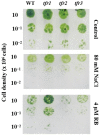Green Microalgae Strain Improvement for the Production of Sterols and Squalene
- PMID: 34451718
- PMCID: PMC8399004
- DOI: 10.3390/plants10081673
Green Microalgae Strain Improvement for the Production of Sterols and Squalene
Abstract
Sterols and squalene are essential biomolecules required for the homeostasis of eukaryotic membrane permeability and fluidity. Both compounds have beneficial effects on human health. As the current sources of sterols and squalene are plant and shark oils, microalgae are suggested as more sustainable sources. Nonetheless, the high costs of production and processing still hinder the commercialization of algal cultivation. Strain improvement for higher product yield and tolerance to harsh environments is an attractive way to reduce costs. Being an intermediate in sterol synthesis, squalene is converted to squalene epoxide by squalene epoxidase. This step is inhibited by terbinafine, a commonly used antifungal drug. In yeasts, some terbinafine-resistant strains overproduced sterols, but similar microalgae strains have not been reported. Mutants that exhibit greater tolerance to terbinafine might accumulate increased sterols and squalene content, along with the ability to tolerate the drug and other stresses, which are beneficial for outdoor cultivation. To explore this possibility, terbinafine-resistant mutants were isolated in the model green microalga Chlamydomonas reinhardtii using UV mutagenesis. Three mutants were identified and all of them exhibited approximately 50 percent overproduction of sterols. Under terbinafine treatment, one of the mutants also accumulated around 50 percent higher levels of squalene. The higher accumulation of pigments and triacylglycerol were also observed. Along with resistance to terbinafine, this mutant also exhibited higher resistance to oxidative stress. Altogether, resistance to terbinafine can be used to screen for strains with increased levels of sterols or squalene in green microalgae without growth compromise.
Keywords: Chlamydomonas; biodiesel; squalene; sterol; terbinafine.
Conflict of interest statement
The authors declare no conflict of interest.
Figures








References
-
- Solomon E.P., Berg L.R., Martin D.W. Biology. 8th ed. Thomson-Brooks/Cole; Belmont, CA, USA: 2008. p. 1376.
-
- Randhir A., Laird D.W., Maker G., Trengove R., Moheimani N.R. Microalgae: A potential sustainable commercial source of sterols. Algal. Res. 2020;46:101772. doi: 10.1016/j.algal.2019.101772. - DOI
-
- Caroprese M., Albenzio M., Ciliberti M.G., Francavilla M., Sevi A. A mixture of phytosterols from Dunaliella tertiolecta affects proliferation of peripheral blood mononuclear cells and cytokine production in sheep. Vet. Immunol. Immunopathol. 2012;150:27–35. doi: 10.1016/j.vetimm.2012.08.002. - DOI - PubMed
LinkOut - more resources
Full Text Sources
Medical
Research Materials

